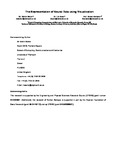The Representation of Neural Data using Visualization
| dc.contributor.author | Stuart, EJ | |
| dc.date.accessioned | 2017-06-21T07:40:00Z | |
| dc.date.accessioned | 2017-06-21T10:30:21Z | |
| dc.date.available | 2017-06-21T07:40:00Z | |
| dc.date.available | 2017-06-21T10:30:21Z | |
| dc.date.issued | 2004-06-10 | |
| dc.identifier.issn | 1473-8724 | |
| dc.identifier.issn | 1473-8724 | |
| dc.identifier.uri | http://hdl.handle.net/10026.1/9509 | |
| dc.description.abstract |
<jats:p> Currently, the focus of research within Information Visualization is steering towards genomic data visualization due to the level of activity that the Human Genome Project has generated. However, the Human Brain project, renowned within Neuroinformatics, is equally challenging and exciting. Its main aim is to increase current understanding of brain function such as memory, learning, attention, emotions and consciousness. It is understood that this task will require the ‘integration of information from the level of the gene to the level of behaviour'. The work presented in this paper focuses on the visualization of neural data. More specifically, the data being analysed is multi-dimensional spike train data. Traditional methods, such as the ‘raster plot’ and the ‘cross-correlogram', are still useful but they do not scale up for larger assemblies of neurons. In this paper, a new innovative method called the Tunnel is defined. Its design is based on the principles of Information Visualization; overview the data, zoom and filter data, data details on demand. The features of this visualization environment are described. This includes data filtering, navigation and a ‘flat map’ overview facility. Additionally, a ‘coincidence overlay map’ is presented. This map washes the Tunnel with colour, which encodes the coincidence of spikes. </jats:p> | |
| dc.format.extent | 245-256 | |
| dc.language | en | |
| dc.language.iso | en | |
| dc.publisher | SAGE Publications | |
| dc.relation.replaces | http://hdl.handle.net/10026.1/9505 | |
| dc.relation.replaces | 10026.1/9505 | |
| dc.relation.replaces | 10026.1/8546 | |
| dc.relation.replaces | http://hdl.handle.net/10026.1/8546 | |
| dc.subject | Neurosciences | |
| dc.subject | 1.2 Psychological and socioeconomic processes | |
| dc.subject | Neurological | |
| dc.title | The Representation of Neural Data using Visualization | |
| dc.type | journal-article | |
| dc.type | Article | |
| plymouth.edition | 2004 | |
| plymouth.issue | 4 | |
| plymouth.volume | 3 (4) | |
| plymouth.publication-status | Published | |
| plymouth.journal | Information Visualization | |
| dc.identifier.doi | 10.1057/palgrave.ivs.9500071 | |
| pubs.merge-from | 10026.1/8546 | |
| pubs.merge-from | http://hdl.handle.net/10026.1/8546 | |
| plymouth.organisational-group | /Plymouth | |
| plymouth.organisational-group | /Plymouth/Faculty of Science and Engineering | |
| plymouth.organisational-group | /Plymouth/Faculty of Science and Engineering/School of Engineering, Computing and Mathematics | |
| plymouth.organisational-group | /Plymouth/REF 2021 Researchers by UoA | |
| plymouth.organisational-group | /Plymouth/REF 2021 Researchers by UoA/UoA11 Computer Science and Informatics | |
| plymouth.organisational-group | /Plymouth/Users by role | |
| plymouth.organisational-group | /Plymouth/Users by role/Academics | |
| plymouth.organisational-group | /Plymouth/Users by role/Researchers in ResearchFish submission | |
| dc.rights.embargodate | 2005-06-10 | |
| dc.identifier.eissn | 1473-8724 | |
| dc.rights.embargoperiod | 12 months | |
| rioxxterms.versionofrecord | 10.1057/palgrave.ivs.9500071 | |
| rioxxterms.licenseref.uri | http://www.rioxx.net/licenses/under-embargo-all-rights-reserved | |
| rioxxterms.type | Journal Article/Review |


